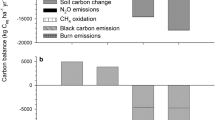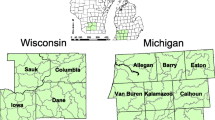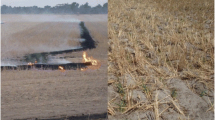Abstract
Purpose
The purpose of this study is to assess and calculate the potential impacts of climate change on the greenhouse gas (GHG) emissions reduction potentials of combined production of whole corn bioethanol and stover biomethanol, and whole soybean biodiesel and stalk biomethanol. Both fuels are used as substitutes to conventional fossil-based fuels. The product system includes energy crop (feedstock) production and transportation, biofuels processing, and biofuels distribution to service station.
Methods
The methodology is underpinned by life cycle thinking. Crop system model and life cycle assessment (LCA) model are linked in the analysis. The Decision Support System for Agrotechnology Transfer – crop system model (DSSAT-CSM) is used to simulate biomass and grain yield under different future climate scenarios generated using a combination of temperature, precipitation, and atmospheric CO2. Historical weather data for Gainesville, Florida, are obtained for the baseline period (1981–1990). Daily minimum and maximum air temperatures are projected to increase by +2.0, +3.0, +4.0, and +5.0 °C, precipitation is projected to change by ±20, 10, and 5 %, and atmospheric CO2 concentration is projected to increase by +70, +210, and +350 ppm. All projections are made throughout the growing season. GaBi 4.4 is used as primary LCA modelling software using crop yield data inputs from the DSSAT-CSM software. The models representation of the physical processes inventory (background unit processes) is constructed using the ecoinvent life cycle inventory database v2.0.
Results and discussion
Under current baseline climate condition, net greenhouse gas (GHG) emissions savings per hectare from corn-integrated biomethanol synthesis (CIBM) and soybean-integrated biomethanol synthesis (SIBM) were calculated as −8,573.31 and −3,441 kg CO2-eq. ha−1 yr−1, respectively. However, models predictions suggest that these potential GHG emissions savings would be impacted by changing climate ranging from negative to positive depending on the crop and biofuel type, and climate scenario. Increased atmospheric level of CO2 tends to minimise the negative impacts of increased temperature.
Conclusions
While policy measures are being put in place for the use of renewable biofuels driven by the desire to reduce GHG emissions from the use of conventional fossil fuels, climate change would also have impacts on the potential GHG emissions reductions resulting from the use of these renewable biofuels. However, the magnitude of the impact largely depends on the biofuel processing technology and the energy crop (feedstock) type.



Similar content being viewed by others
References
Berg A, De Noblet-Ducoudré N, Sultan B, Lengaigne M, Guimberteau M (2013) Projections of climate change impacts on potential C4 crop productivity over tropical regions. Agric Forest Met 170:89–102
Börjesson P, Tufvesson LM (2011) Agricultural crop-based biofuels – resource efficiency and environmental performance including direct land use changes. J Cleaner Prod 19(2–3):108–120
Eyshi-Rezaie E, Bannayan M (2012) Rainfed wheat yields under climate change in northeastern Iran. Met Appl 19(3):346–354
Fargione J, Hill J, Tilman D, Polasky S, Hawthorne P (2008) Land clearing and the biofuel carbon debt. Science 319(5867):1235–1238
Fischer G, Shah M, Velthuizen H (2002) Climate change and agricultural vulnerability. RemaPrint, Vienna: IIASA Publishing Department [viewed 06/04/2010]
Frondel M, Peters J (2007) Biodiesel: a new oildorado? En Policy 35(3):1675–1684
Gelfand I, Sahajpal R, Zhang X, Izaurralde RC, Gross KL, Robertson GP (2013) Sustainable bioenergy production from marginal lands in the US Midwest. Nature, 01-16. Available from:http://feeds.nature.com/~r/nature/rss/aop/~3/GwIPXr0hev8/nature11811
González-García S, Gasol CM, Gabarrell X, Rieradevall J, Moreira MT, Feijoo G (2010) Environmental profile of ethanol from poplar biomass as transport fuel in southern Europe. Ren Energy 35(5):1014–1023
Gornall J, Betts R, Burke E, Clark R, Camp J, Willett K, Wiltshire A (2010) Implications of climate change for agricultural productivity in the early twenty-first century. Philosophical Transactions of the Royal Society B: Biol Sciences 365(1554):2973–2989
Gungula DT, Kling JG, Togun AO (2003) CERES-Maize predictions of maize phenology under nitrogen-stressed conditions in Nigeria. Agron J 95(4):892–899
Hoffman LA, Baker A (2011) Estimating the substitution of distillers' grains for corn and soybean meal in the U.S. feed complex. USDA Economic Research Service - what's New, Thu, 13 Oct.
Hoogenboom G, Jones JW, Porter CH, Wilkens PW, Boote KJ, Batchelor WD, Hunt LA, Tsuiji GY (2003) Decision Support System for Agrotechnology Transfer Version 4.0. Volume 1: Overview. ed. University of Hawaii, Honolulu, HI: University of Hawaii
IPCC (2007) Climate Change 2007: Impacts, Adaptation and Vulnerability. Contribution of working group II to the fourth assessment report of the Intergovernmental Panel on Climate Change. Parry ML, Canziani OF, Palutikof JP, Van Der Linden PJ, Hanson CE (eds) Cambridge, UK: Cambridge University Press [viewed 11/12/2009]. Available from: http://www.ipcc.ch/ipccreports/ar4-wg2.htm
IPCC (2007) Climate change 2007: synthesis report. http://www.ipcc.ch/publications_and_data/publications_ipcc_fourth_assessment_report_synthesis_report.htm ed. [viewed 12/25/2009]
ISO (2006) Environmental management - life cycle assessment - principles and framework (ISO 14040). The International Organisation for Standardisation
Jones JW, Hoogenboom G, Porter CH, Boote KJ, Batchelor WD, Hunt LA, Wilkens PW, Singh U, Gijsman AJ, Ritchie JT (2003) The DSSAT cropping system model. Eur J Agron 18(3–4):235–265
Larson ED (2006) A review of life-cycle analysis studies on liquid biofuel systems for the transport sector. En Sust Dev 10(2):109–126
McCormick RL (2007) The impact of biodiesel on pollutant emissions and public health. Inh Tox 19(12):1033–1039
Müller C, Cramer W, Hare WL, Lotze-Campen H (2011) Climate change risks for African agriculture. Proc Natl Acad Sci U S A 108(11):4313–4315
Naik SN, Goud VV, Rout PK, Dalai AK (2010) Production of first and second generation biofuels: a comprehensive review. Ren Sust Energy Rev 14(2):578–597
Nguyen TLT, Gheewala SH, Garivait S (2007) Fossil energy savings and GHG mitigation potentials of ethanol as a gasoline substitute in Thailand. Energy Pol 35(10):5195–5205
Nguyen TLT, Gheewala SH, Bonnet S (2008) Life cycle cost analysis of fuel ethanol produced from Cassava in Thailand. Int J Life Cycle Assess 13(7):564–574
Oliver RJ, Finch JW, Taylor G (2009) Second generation bioenergy crops and climate change: a review of the effects of elevated atmospheric CO2 and drought on water use and the implications for yield. GCB Bioenergy 1(2):97–114
Persson T, Garcia y Garcia A, Paz J, Jones J, Hoogenboom G (2009a) Maize ethanol feedstock production and net energy value as affected by climate variability and crop management practices. Agric Systems 100(1-3):11–21
Persson T, Garcia y Garcia A, Paz JO, Jones JW, Hoogenboom G (2009b) Net energy value of maize ethanol as a response to different climate and soil conditions in the southeastern USA. Biom Bioen 33(8):1055–1064
Persson T, Ortiz BV, Bransby DI, Wu W, Hoogenboom G (2011) Determining the impact of climate and soil variability on switchgrass (Panicum virgatum L.) production in the south-eastern USA; a simulation study. Biof Bioprod Bioref 5(5):505–518
Renó MLG, Lora EES, Palacio JCE, Venturini OJ, Buchgeister J, Almazan O (2011) A LCA (life cycle assessment) of the methanol production from sugarcane bagasse. Energy 36(6):3716–3726
Ritchie JT, Singh U, Godwin DC, Bowen WT (1998) Cereal growth, development and yield. Tsuiji, G.Y., Hoogenboom, G., and Thornton, P.K. ed, 7th edn. Kluwer Academic Publishers, Dordrecht, The Netherlands
Rötter RP, Palosuo T, Kersebaum KC, Angulo C, Bindi M, Ewert F, Ferrise R, Hlavinka P, Moriondo M, Nendel C, Olesen JE, Patil RH, Ruget F, Takáč J, Trnka M (2012) Simulation of spring barley yield in different climatic zones of northern and central Europe: a comparison of nine crop models. Field Crops Res 133:23–36
Searchinger T, Heimlich R, Houghton RA, Dong F, Elobeid A, Fabiosa J, Tokgoz S, Hayes D, Yu T (2008) Use of U.S. croplands for biofuels increases greenhouse gases through emissions from land-use change. Science 319(5867):1238–1240
Sims REH, Hastings A, Schlamadinger B, Taylor G, Smith P (2006) Energy crops: current status and future prospects. Glo Change Biol 12(11):2054–2076
Sims REH, Mabee W, Saddler JN, Taylor M (2010) An overview of second generation biofuel technologies. Biores Tech 101(6):1570–1580
Stromberg PM, Esteban M, Gasparatos A (2011) Climate change effects on mitigation measures: the case of extreme wind events and Philippines' biofuel plan. Env Science Pol 14(8):1079–1090
Teixeira EI, Fischer G, Van Velthuizen H, Walter C, Ewert F (2013) Global hot-spots of heat stress on agricultural crops due to climate change. Agric Forest Met 170:206–215
Tuck G, Glendining MJ, Smith P, House JI, Wattenbach M (2006) The potential distribution of bioenergy crops in Europe under present and future climate. Biom Bioen 30(3):183–197
Wang H, He Y, Qian B, McConkey B, Cutforth H, McCaig T, McLeod G, Zentner R, DePauw R, Lemke R, Brandt K, Liu T, Qin X, White J, Hunt T, Hoogenboom G (2012) Short communication: climate change and biofuel wheat: a case study of southern Saskatchewan. Can J Plant Sc 92(3):421–425
Author information
Authors and Affiliations
Corresponding author
Additional information
Responsible editor: Mary Ann Curran
Rights and permissions
About this article
Cite this article
Garba, N.A., Duckers, L.J. & Hall, W.J. Climate change impacts on life cycle greenhouse gas (GHG) emissions savings of biomethanol from corn and soybean. Int J Life Cycle Assess 19, 806–813 (2014). https://doi.org/10.1007/s11367-013-0680-3
Received:
Accepted:
Published:
Issue Date:
DOI: https://doi.org/10.1007/s11367-013-0680-3




